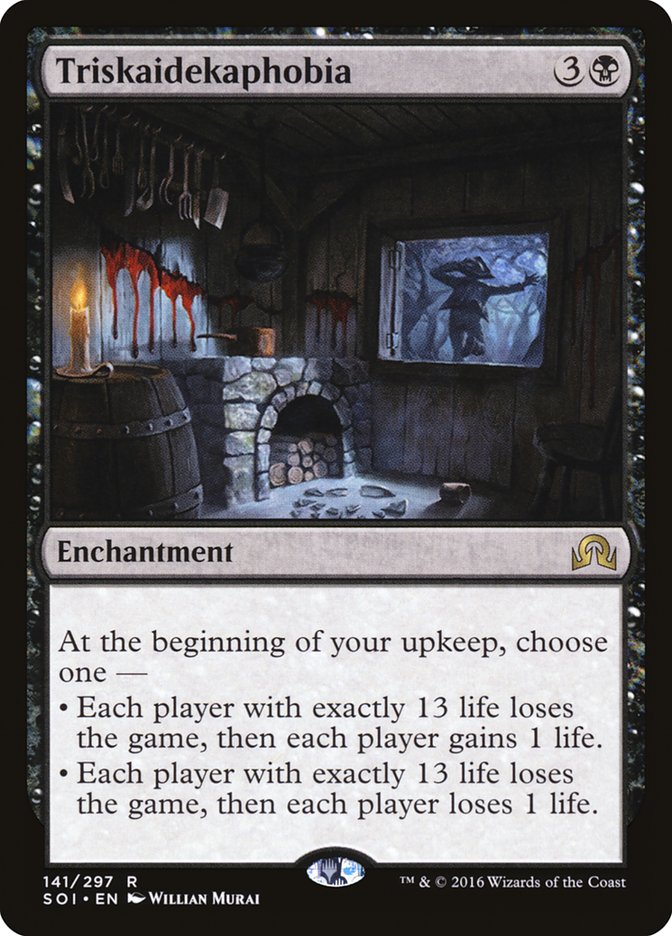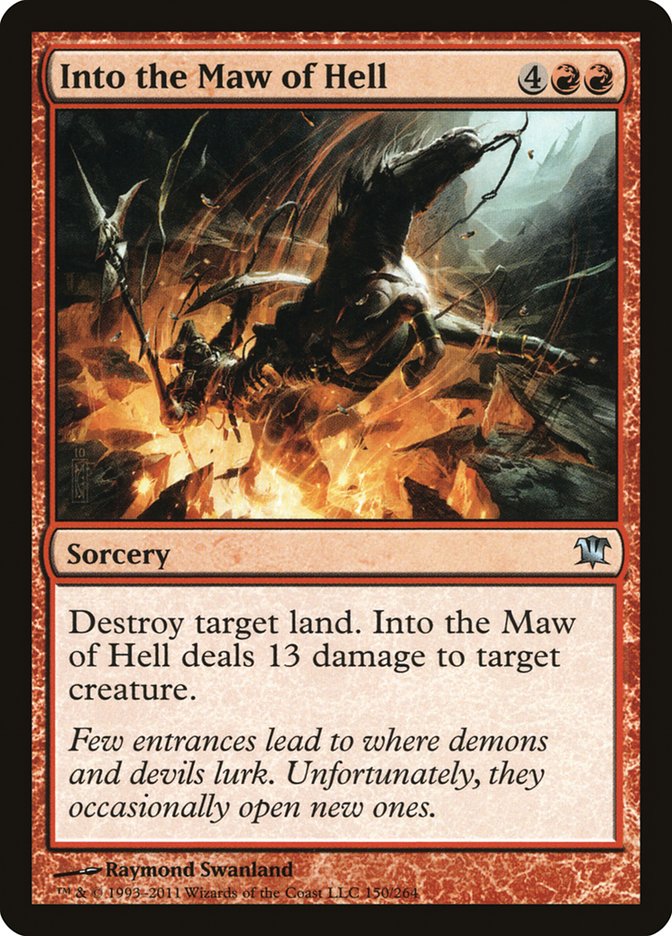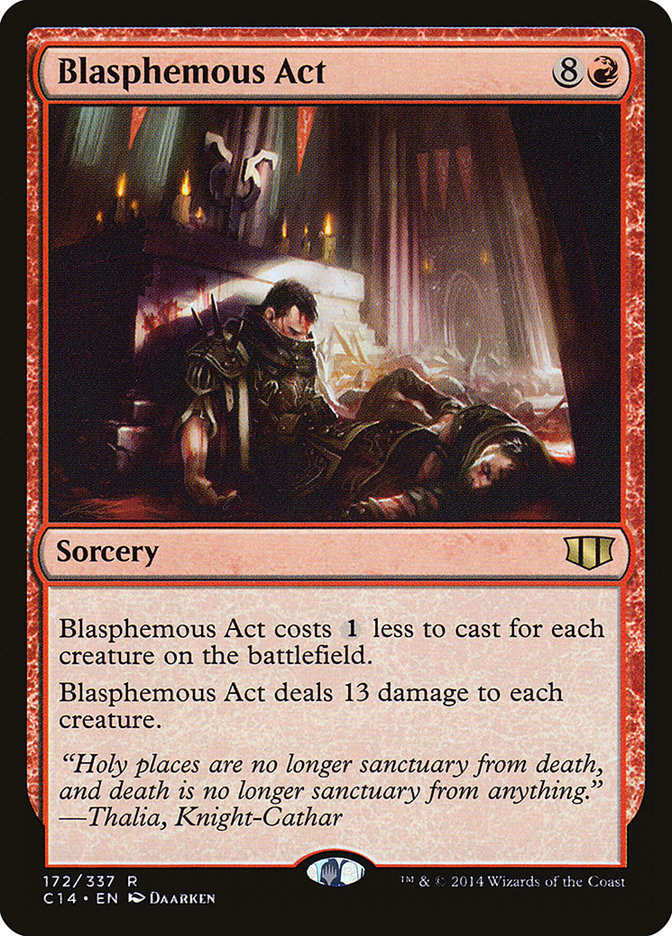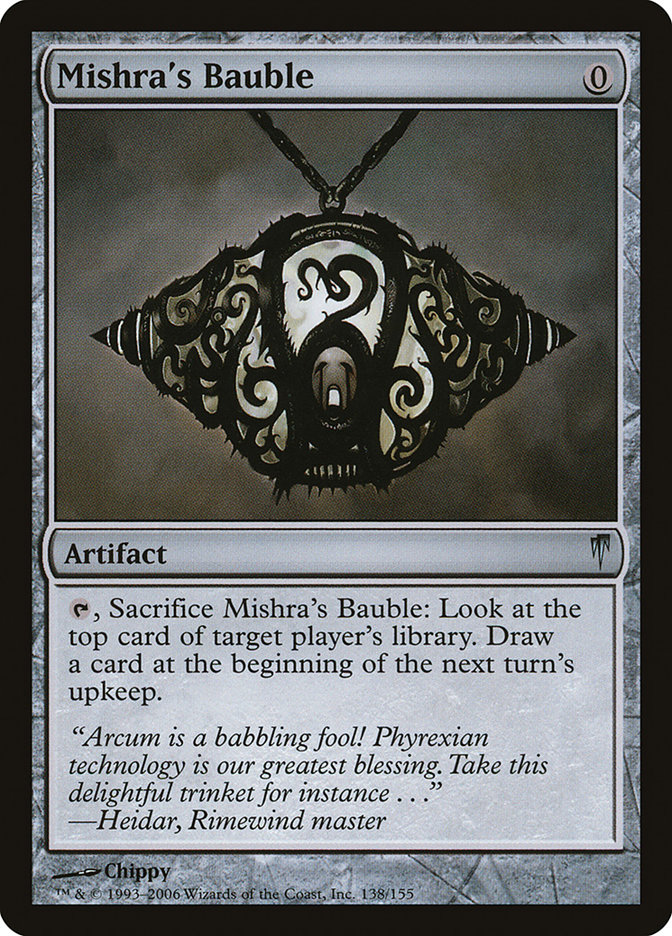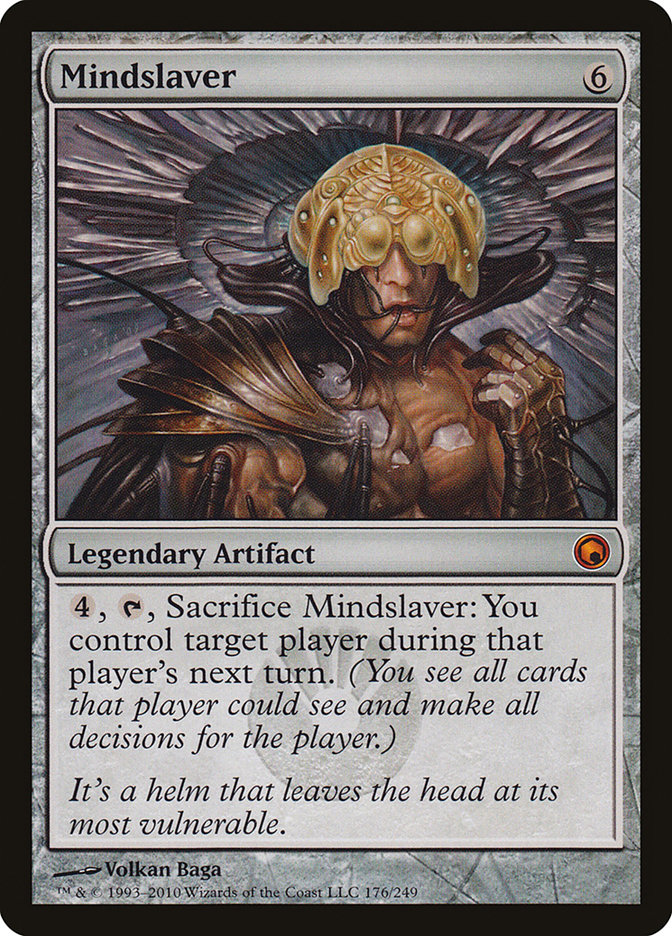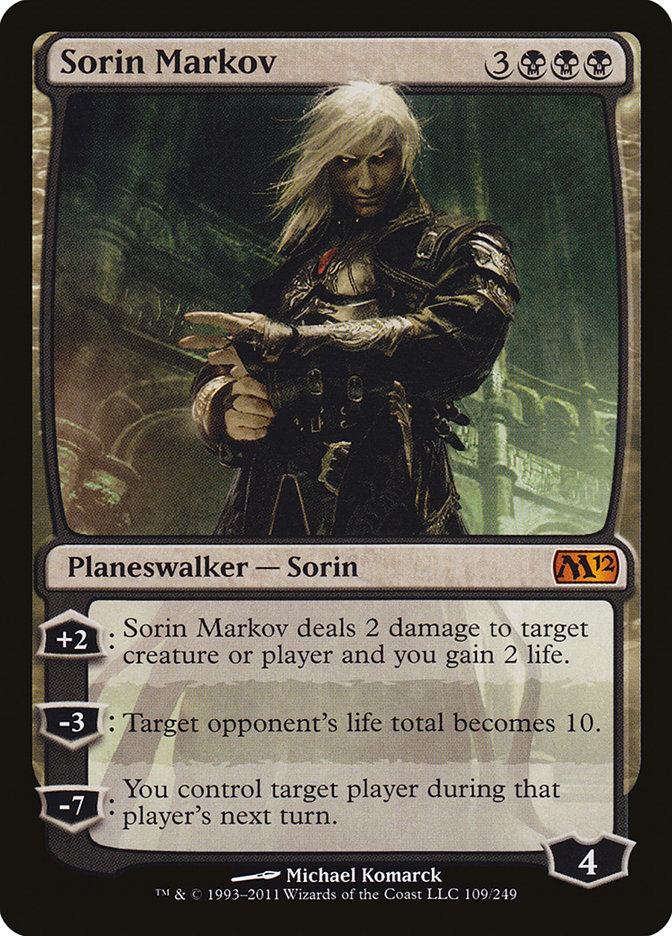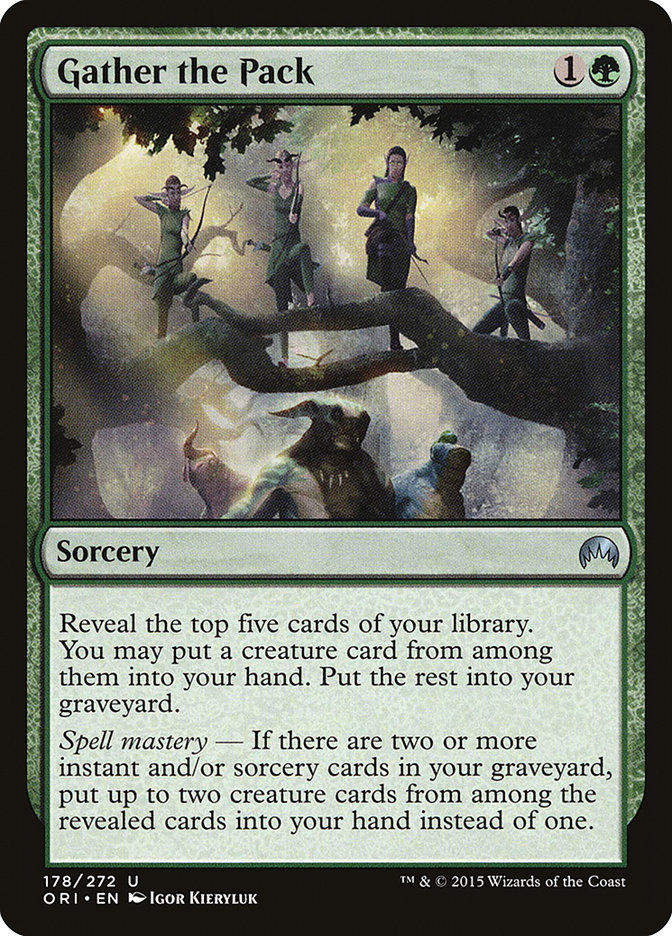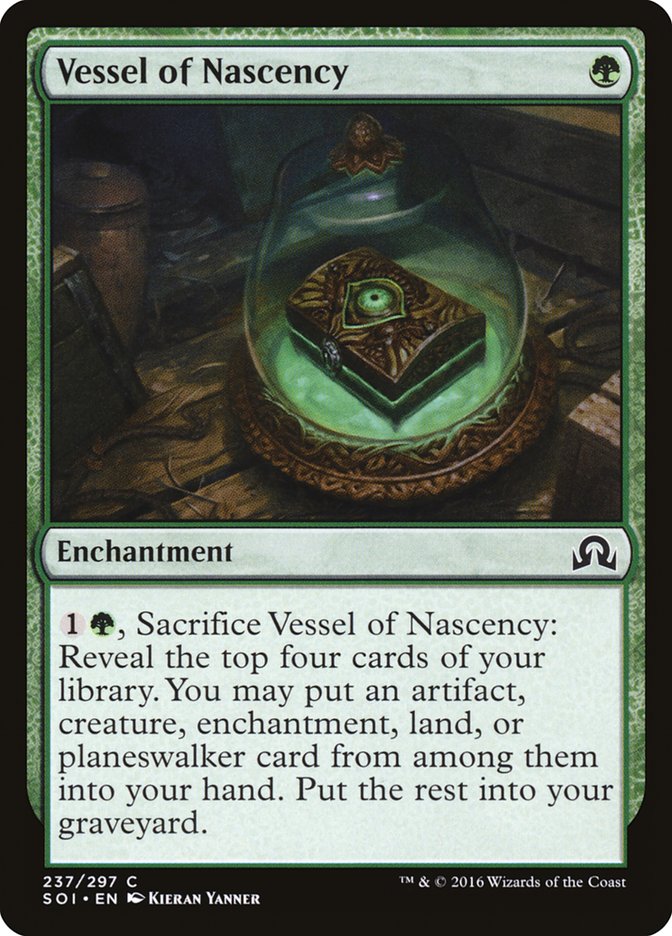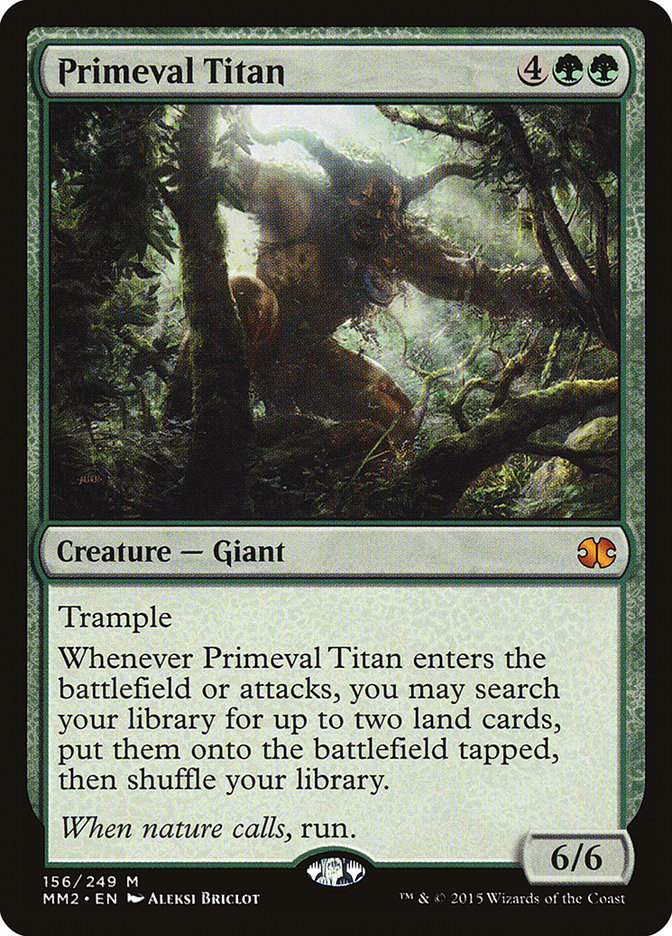When I woke up this morning, the first thing I saw was a friend’s post expressing disappointment at the new Emrakul, so I hopped over to Twitter to find a link to it. As far as I’m concerned, if you’re disappointed with Emrakul, the Promised End, you were going to be disappointed with anything. Clearly the buildup was just too much, and no mere printed text could live up to it. For me, though, wow. I’m impressed. I love everything about it.
When the Eldrazi first showed up on Zendikar in Rise of the Eldrazi, everything unique about Zendikar immediately disappeared. The Eldrazi destroyed it, and the set was no longer even part of the same block really because everything was so different. Battle for Zendikar felt more like an Eldrazi set than a Zendikar set to me, though the original Zendikar flavor was for more present than it had been in Rise of Eldrazi. Still, I was concerned about Eldritch Moon.
See, Innistrad is an awesome set because of its flavor and feel, and it’s very easy to imagine adding Eldrazi distracting from that, and really diminishing the effect. Now, when I first realized that they were just using Emrakul as a Cthulhu stand-in to transition to Lovecraftian horror, I decided that would probably be pretty cool; it’s not quite the Gothic horror of original Innistrad, but not far off. Still, there were fears about really committing to it and not turning this into another Eldrazi set. As such, I love little things like making Emrakul, the Promised End a 13/13 for thirteen mana. It’s not far enough off to stop feeling like Emrakul, but it feels much more at home as part of Innistrad, and it fits perfectly with playing up the thirteen theme in Shadows over Innistrad.
Next, the art is great, especially the full version. So much detail! Like all the windows in the buildings in the background. It’s also just a perfect execution of Emrakul on Innistrad, rather than just “Emrakul, which happens to be near Innistrad.”
As for the actual text, I love both the gameplay and the flavor. First, Shadows over Innistrad had already established the link between card types your graveyard and delirium, so the more delirious you are, the easier it is to summon Emrakul. Beyond that, you just have to go through a lot of hoops collecting things in your graveyard, in a manner reminiscent of performing some very particular obscure sacrificial ritual. So that’s all pretty cool, but it goes much farther than that.
In terms of gameplay, and more importantly deck design, this ability’s great. Before Pro Tour Shadows over Innistrad, I had a lot of fun trying to make Delirium decks work, but we just weren’t quite there yet. Still, I really like the kinds of decks the mechanic encourages you to build. You want some dedicated enablers, but you also just need to play a mix of card types, so you build a deck that doesn’t necessarily want any planeswalkers or enchantments, but you start looking for a few that might not be too bad, and you find ways to integrate them into your strategy.
I also really like that delirium naturally scales up in older formats. It’s much easier to get more types in the graveyard in Modern where you have fetchlands, Mishra’s Bauble, Thought Scour, and generally just way more options than you do in Standard; but at the same time, the format is a lot less forgiving about you taking time setting up. Still, the added options keep the dream alive in a really interesting way for deckbuilders.
Finally, I like that this card kind of has its own ramping built-in. Building around Eldrazi is generally a little disappointingly obvious. They cost a lot of mana, so you either cheat them onto the battlefield or play a lot of ramp spells. With Emrakul, maybe you don’t play ramp spells. Maybe you just focus on getting six card types in the graveyard by turn 7 and tapping seven lands to cast it. That’s not easy, but it’s far from out of the question, and the card is incredibly powerful for seven mana.
Next up, the “Mindslaver” cast trigger. Mindslaver is a uniquely unpredictable and powerful effect. It’s usually incredibly devastating, sometimes winning the game on the spot, but every now and then, it’s just a Fog. It’s actually possible, if your opponent has nothing going on at all, for Emrakul’s trigger to essentially reduce to “Your opponent draws a card,” though it’s very rare that it’ll backfire that badly.
In terms of flavor, I love the way this represents your opponent being driven crazy by the sight of Emrakul. They go temporarily insane but then regain control and try to pull themselves together. This makes it feel very different from something like Sorin Markov’s ultimate that just controls their mind directly. In terms of gameplay, I also like that it naturally prevents locks like Academy Ruins / Mindslaver, which would be pretty easy to set up with a creature if Emrakul just had a Mindslaver trigger.
Finally, this Emrakul has flying, trample (a welcome addition that was absent from the previous incarnation), and protection from instants. I love protection from instants here. It’s a toned-down homage to the original, but it reads as much more of a downgrade than it actually is. I love that, at first, it makes it look like you should just play sorceries to answer Emrakul, but since you don’t control your turn after Emrakul comes down, there’s a good chance that any sorcery-speed answers you were holding will backfire. Still, it means that if you have sorcery-speed removal in your deck, there’s an exciting moment where you get to see if you topdeck it on your bonus turn to get one last shot at answering it before it can attack.
So the card is sweet, but as you know, this is a column about competitive Magic, so the real question is whether it’s good, and where and how. Obviously, without knowing the rest of the set, it’s hard to say anything conclusive, especially about Standard, but I definitely expect Emrakul, the Promised End to be an important card in the upcoming Standard season.
The best card in any format, I think, to take advantage of Emrakul, the Promised End will be Traverse the Ulvenwald. First off, it’s an easy way to start the game with a sorcery in your graveyard. Second, obviously, if you’re trying to cast Emrakul, you’re almost definitionally trying to get delirium, and at that point, why fill your deck with thirteen-mana cards that you can’t do anything with for most of the game when you can instead play a one-mana sorcery that has a lot of flexibility and early utility that lets you find Emrakul when you’re ready? Maybe you’re not playing green, but maybe you should be.
In Standard, another great piece of the puzzle may be Gather the Pack. Gather the Pack is another way to find Emrakul that also helps get delirium. The only problem with Gather the Pack is that it’s tricky to get all the numbers right in deckbuilding. It wants enough instants and sorceries that you can have spell mastery some portion of the time, but it also wants you to have enough creatures that you’ll almost never miss, and ideally that you’ll hit two.
Gather the Pack doesn’t cost as much mana as Collected Company, and milling accomplishes something regardless of whether you hit, so despite seeing one less card, I don’t think you have to play as many creatures as you do for Collected Company, and obviously they can cost any amount, but it still might be tricky to get a deck that’s good at getting delirium that has more than twenty creatures.
Another similar option that helps even more with delirium is Vessel of Nascency. The trick with this one is that it costs an extra mana, and the extra mana is a huge problem if you’re playing tapped lands, because you really don’t want to have to use most of your mana on it on turn 3 or 4; if you want to use it early, you basically have to play it on turn 1 and activate it on turn 2, which requires playing two untapped lands, but it’s not necessarily easy to start a game in this Standard format with two untapped lands.
The good news: if you’re playing Vessel of Nascency and Traverse the Ulvenwald, you can lean on them for fixing and play more basic lands. The bad news: if you’re trying to get delirium, you still probably at least want Evolving Wilds.
I think it would be crazy to try to build a Standard deck with Emrakul without knowing more of the set. [Copy Editor’s Note: Patrick Chapin says, “Challenge accepted!”] I have to imagine that a set built around this card will have a number of important enablers to play alongside it in Standard. I will say that I’d love if this means Mindwrack Demon gets a chance to shine. Stasis Snare and Clip Wings should also be kept in mind, as they’ll be among the best ways to fight Emrakul, the Promised End.
In Modern, while I ultimately don’t like the deck, my Temur Traverse deck from the Magic Online Championship is a natural fit for Emrakul, or at least something very close to it. I like Traverse the Ulvenwald, Tarmogoyf, Mishra’s Bauble, and some cheap blue cantrips as a starting point. I’m not sure what the third color should be, or maybe it could even be four colors. I like that red lets you play things like Tarfire and Seal of Fire that are cheap, easy ways to get weird types in the graveyard, but it wouldn’t be out of the question to play Nameless Inversion in black.
I want to play something that makes the deck better at answering opposing Tarmogoyfs. Sakura-Tribe Elder is a card I’ve had in and out of sketches of decks along these lines that gets a lot better if you’re trying to cast Emrakul, since you’ll need a lot more mana, and it’s a good, reliable way to get a creature in the graveyard quickly.
While I’d like to see more midrange delirium decks show up in Modern to try to cast Emrakul, the Promised End, realistically, I don’t think that’s how that format actually works, and if people play Emrakul, it’ll be in traditional ramp decks like Tron (especially Blue Tron) and Green Devotion, and then it might have a slight warping effect on those decks, like pushing G/R Tron to play Kozilek’s Return over Pyroclasm (though I think they’re already going that way).
So what might a new Green Eldrazi deck look like?
Creatures (20)
- 4 Sakura-Tribe Elder
- 4 Arbor Elf
- 4 Primeval Titan
- 1 Hornet Queen
- 2 Courser of Kruphix
- 1 Ulamog, the Ceaseless Hunger
- 3 World Breaker
- 1 Emrakul, the Promised End
Lands (17)
Spells (23)

This deck isn’t extremely dedicated to delirium and uses Ancient Stirrings rather than Traverse the Ulvenwald so that it can find Eldrazi Temples, which it can untap with Garruk Wildspeaker. It’s fairly good at getting land, sorcery, enchantment, creature, and planeswalker in the graveyard, and it has a single instant in Kozilek’s Return with several more in the sideboard, along with a few artifacts in Tormod’s Crypt. I expect Emrakul, the Promised End to usually cost around nine by the time you’re trying to cast it, and I think it’s good to have access to at that cost.
This take combines mana engines from a few decks I’ve worked on in the past in a way I haven’t before, but I think they play well together. I don’t expect Nykthos, Shrine to Nyx to be a huge part of this deck, but I suspect Primeval Titan will almost always want to find it, as once you have a Titan on the battlefield, it should be worth more mana than an Eldrazi Temple, though the Eldrazi Temples are very important earlier, especially when the Thought-Knot Seers are in.
At the time of writing this, I’ve only seen three cards from Eldritch Moon, but I’m really excited to see the rest, and I can’t wait to start working on Standard for Pro Tour Eldritch Moon in Sydney. I do, however, want to end on a slightly different note.
Not Very Eternal
I’ve been having a lot of fun playing a lot of Eternal Masters recently, and I was reminded how bizarre I thought it was that there were no large events using the set. I tweeted about how baffled I was, and I saw that a lot of others felt similarly. I’ve come to understand it, I think, and I figured others might be interested; I know I always like to understand why Wizards of the Coast does the things they do.
When printing a set like Eternal Masters, WotC is trying to make older cards a little more accessible, but the key is that they only want to make them a little more accessible, because they don’t want prices to plummet and they want people to have confidence in the values of their cards as investments as much as possible. What this means is that they don’t print these sets to demand; they decide how much they want to add to the market, and they print exactly that much. This is why these sets tend to sell for above MSRP.
While players love events like Grand Prix Las Vegas with Modern Masters, these events are bad for WotC’s bottom line, because rather than selling a large portion of the finite number of packs they’ve decided they can safely print to stores, they give them to tournament organizers to run the events, where WotC realizes a much lower portion of the profit. For the same reason, it’s also better for every local store that there isn’t a Grand Prix, as all of them have access to more Eternal Masters packs they can sell.
For players, it can be infuriating that we can’t have an event that everyone knows we love, but there is some actual business sense behind the decision.



